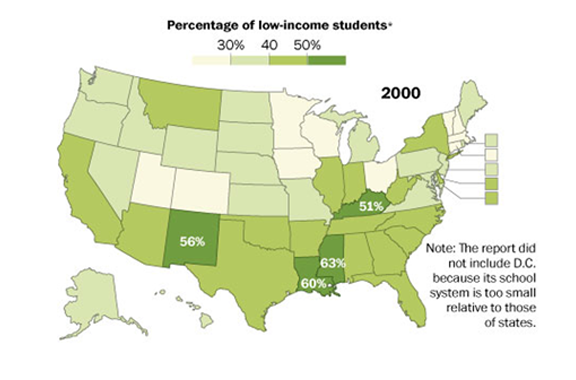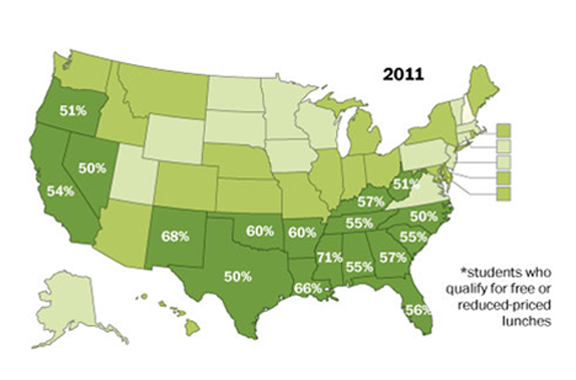Graphic; Low-income students made up at least half the public school student population in 17 states in 2011, a marked increase from 2000, when four states topped 50 percent.
By Lyndsey Layton | Originally Published at The Washington Post. October 16 E-mail the writer
A majority of students in public schools throughout the American South and West are low-income for the first time in at least four decades, according to a new study that details a demographic shift with broad implications for the country.
The analysis by the Southern Education Foundation, the nation’s oldest education philanthropy, is based on the number of students from preschool through 12th grade who were eligible for the federal free and reduced-price meals program in the 2010-11 school year.
The meals program run by the Department of Agriculture is a rough proxy for poverty, because a family of four could earn no more than $40,793 a year to qualify in 2011.
Children from those low-income families dominated classrooms in 13 states in the South and the four Western states with the largest populations in 2011, researchers found. A decade earlier, just four states reported poor children as a majority of the student population in their public schools.
But by 2011, almost half of the nation’s 50 million public-school students — 48 percent — qualified for free or reduced-price meals. In some states, such as Mississippi, that proportion rose as high as 71 percent.
In a large swath of the country, classrooms are filling with children who begin kindergarten already behind their more privileged peers, who lack the support at home to succeed and who are more than likely to drop out of school or never attend college.
“This is incredible,” said Michael A. Rebell, the executive director of the Campaign for Educational Equity at Columbia University, who was struck by the rapid spike in poverty. He said the change helps explain why the United States is lagging in comparison with other countries in international tests.
“When you break down the various test scores, you find the high-income kids, high-achievers are holding their own and more,” Rebell said. “It’s when you start getting down to schools with a majority of low-income kids that you get astoundingly low scores. Our real problem regarding educational outcomes is not the U.S. overall, it’s the growing low-income population.”
Southern states have seen rising numbers of poor students for the past decade, but the trend spread west in 2011, to include rapidly increasing levels of poverty among students in California, Nevada, Oregon and New Mexico.
The 2008 recession, immigration and a high birthrate among low-income families have largely fueled the changes, said Steve Suitts, vice president of the Southern Education Foundation and an author of the study.
Maryland and Virginia were the only Southern states where low-income children did not make up a majority of public-school students. About one-third of students in public schools in Maryland and Virginia qualified for the free and reduced meals program in 2011.
Hank Bounds, the Mississippi commissioner of higher education, said the country needs to figure out how to educate the growing classes of poor students and reverse the trend.
“Lots of folks say we need to change this paradigm, but as a country, we’re not focusing on the issue,” said Bounds, who was previously Mississippi’s state school superintendent. “What we’re doing is not working. We need to get philanthropies, the feds, business leaders, everybody, together and figure this out. We need another Sputnik moment.”
National efforts to improve public education — from the Bush administration’s No Child Left Behind to President Obama’s Race to the Top — have been focused on the wrong problems, said Richard Rothstein, a senior fellow at the Institute on Law and Social Policy at the University of California at Berkeley.
Most of those changes, including the rise of standardized testing, holding teachers accountable for their students’ academic performance and rewriting math and reading standards don’t address poverty, Rothstein said.
“If you take children who come to school from families with low literacy, who are not read to at home, who have poor health — all these social and economic problems — and just say that you’re going to test children and have high expectations and their achievement will go up, it doesn’t work,” Rothstein said. “It’s a failure.”
Instead, schools must adapt to the new low-income majorities, Suitts said.
“We have an education system that continues to assume that most of our students are middle class and have independent resources outside the schools in order to support their education,” Suitts said. “The trends and facts belie that assumption. We can’t continue to educate kids on an assumption that is 20 years out of date. We simply have to reshape our educational system.”
Policymakers, politicians and educators should reconsider the $500 billion the nation spends annually on K-12 education, with an eye toward smarter investments to help poor children, Suitts said.
Because they show up for kindergarten with a working vocabulary half as large as their more privileged peers, low-income children should be enrolled in quality preschool, Suitts said. Poor children also need more time in school with an extended day or school year, and they need health care as well as social and emotional support, he said.
“We have to do something different by the way we educate, but we do it by understanding who are the students and what are the needs,” Suitts said.
On average, the country spends about $10,300 annually per student, but that figure varies wildly among states and even within school districts. In 2011, for instance, New York spent $19,076 for each student, while Utah spent $6,212.
Between 2000 and 2010, average per-pupil spending increased, but more slowly than the growth in low-income students in every region but the Northeast, where per-pupil spending grew faster, the study found.
All three levels of government — federal, state and local — pay for public schools. The federal contribution is about 10 percent, with states and local governments providing the rest.
Because local governments draw on property taxes to provide their share of school funding, poor districts with a limited tax base don’t raise as much money as more affluent communities. That often means that children in poor communities attend schools with fewer resources, substandard facilities and less-qualified teachers.
States with some of the biggest proportions of poor children spend the least on each student, the new study found. Mississippi, for example, spent $7,928 per student in 2011.
“More and more of these kids are in economic distress,” said Gene Nichol, who directs the Center on Poverty, Work and Opportunity at the University of North Carolina and wrote a recent series of stories published in the Raleigh News and Observer that chronicle poverty in that state. “And there’s less and less political will to do the things needed to fix it.”













Leave A Comment